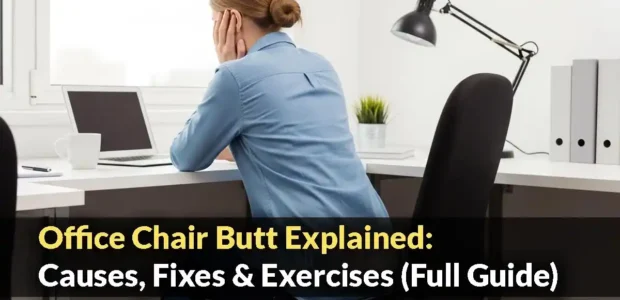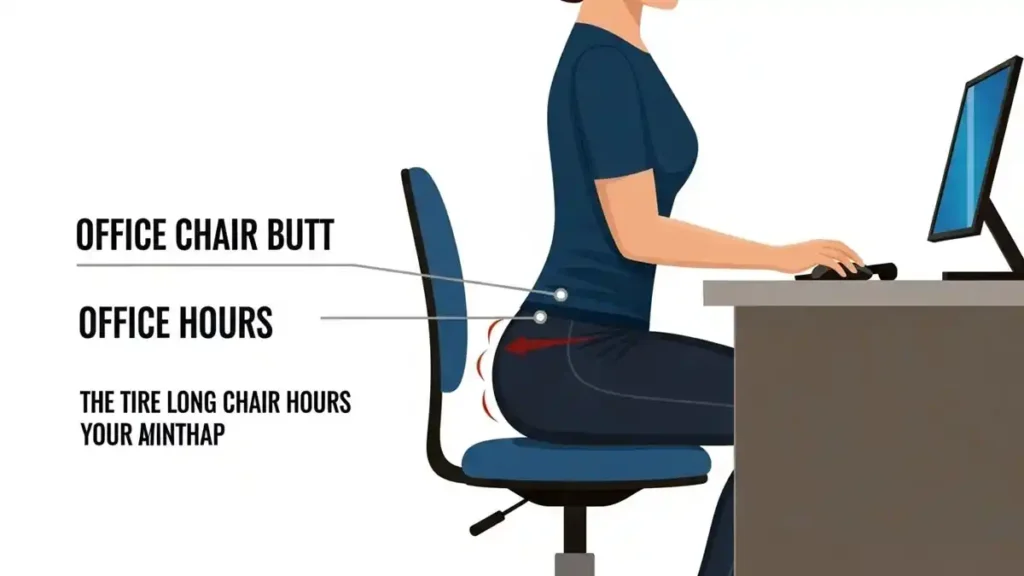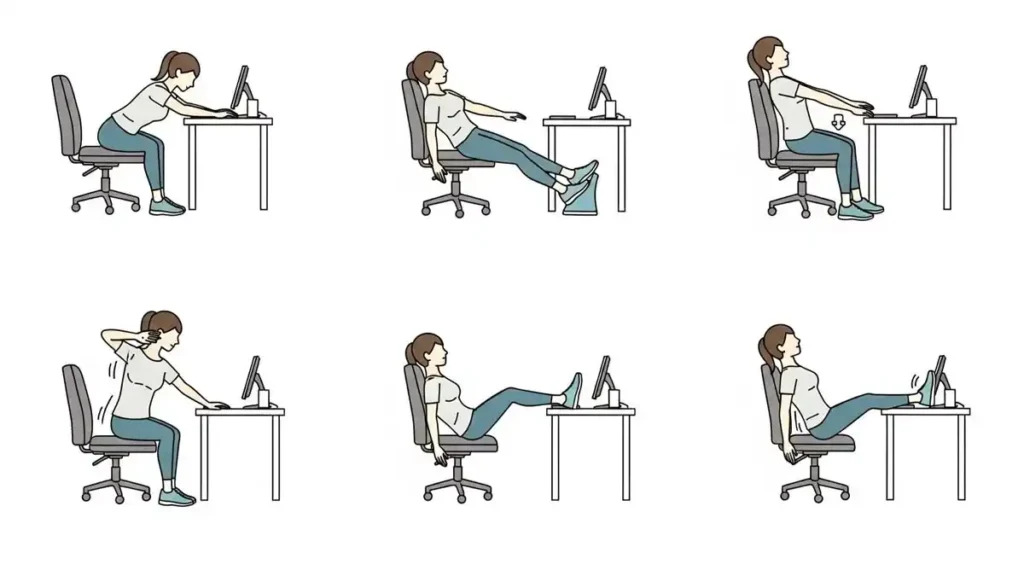
Office Chair Butt Explained: Causes, Fixes & Exercises (Full Guide)
Sitting for long hours at your desk? You might be familiar with the term “Office Chair Butt.” This trending phrase isn’t just social media buzz—it reflects a real issue faced by many desk-bound professionals. In this guide, we’ll break down what office chair butt is, why it happens, and most importantly, how you can fix it.

Read in this post:
What Is Office Chair Butt?
“Office Chair Butt” is a non-medical term that’s gained popularity on platforms like TikTok. It refers to the flattening, softening, or sagging of the gluteal muscles due to prolonged sitting, typically in an office chair.
When you sit for extended periods without movement, your glutes get less stimulation. This can lead to reduced muscle tone, accumulation of fat, and a less defined shape of your backside. In medical terms, this is known as gluteal atrophy or “dead butt syndrome.”
Common signs of office chair butt:
- Flattened or droopy buttocks
- Muscle weakness in the glutes
- Discomfort or numbness in the buttocks
- Poor posture or lower back pain

Why Does Office Chair Butt Happen?
Several factors contribute to this condition:
1. Prolonged Sitting
The biggest culprit is staying seated for hours without movement. Lack of activity decreases blood flow and causes muscles to weaken.
2. Poor Posture
Slouching or leaning forward in your chair can shift pressure onto your lower back and glutes, causing them to weaken over time.
3. Inadequate Chair Support
Chairs without ergonomic design or proper cushioning can put uneven pressure on your hips and buttocks, further stressing the gluteal muscles.
4. Muscle Inactivity
When your glutes remain inactive, they essentially “forget” how to engage, leading to what’s known as gluteal amnesia.
How to Fix Office Chair Butt
The good news is—office chair butt is reversible! With regular movement, proper seating, and a few simple habits, you can regain tone and reduce discomfort.
✅ 1. Take Frequent Breaks
Try to stand or walk every 30–60 minutes. Even a quick stretch or trip to refill your water can help activate the muscles.
✅ 2. Improve Posture
Sit back fully in your chair. Keep your feet flat on the ground, knees at 90°, and spine straight. Use a lumbar support pillow if needed.
✅ 3. Use Ergonomic Seating
Choose a chair with proper back support, seat cushioning, and adjustable features. You can also invest in a quality seat cushion for extra comfort.
✅ 4. Try Standing Desks or Walking Pads
Alternating between sitting and standing can reduce pressure and improve blood flow to your glutes.
✅ 5. Do Glute-Activating Exercises
These exercises will strengthen your muscles and improve posture.

Best Exercises to Reverse Office Chair Butt
Incorporate these easy exercises into your routine—at your desk or at home:
🔹 Seated Desk Exercises
- Butt Clenches: Squeeze your glutes and hold for 5 seconds. Repeat 10–15 times.
- Leg Lifts: While seated, lift one leg straight and hold for 10 seconds. Alternate legs.
- Ankle Circles: Improve circulation and prevent stiffness.

🔹 At-Home Glute Workouts
- Bridges: Lie on your back, bend your knees, and lift your hips. Repeat 10–20 reps.
- Squats: Bodyweight squats activate glutes and thighs.
- Lunges: Forward, backward, and side lunges help tone your glute muscles.
- Clamshells: Lie on your side with knees bent, lift the top knee. Strengthens hips and glutes.

Final Thoughts
Office Chair Butt may sound funny—but it can have serious long-term effects if ignored. The best way to fight it? Stay active, improve posture, invest in ergonomic seating, and make glute-strengthening exercises part of your daily life.
Taking small steps today will not only save your backside—but your overall health and productivity too.
FAQs About Office Chair Butt
1. What is office chair butt?
Office chair butt is a casual term for the flattening or sagging of your glutes caused by prolonged sitting. It happens when your gluteal muscles weaken due to inactivity, leading to a softer, less toned appearance.
2. What does office chair butt look like?
It typically appears as a flat, saggy, or squishy backside. You might notice less roundness or firmness in your glutes, especially if you sit for hours every day without movement.
3. How to fix office chair butt?
You can fix it by:
i. Doing targeted glute exercises like squats and bridges
ii. Using a standing desk or taking movement breaks
iii. Improving your posture and using a better chair or seat cushion
4. How to prevent office chair butt?
Preventing office chair butt is simple if you:
i. Take short walking or standing breaks every hour
ii. Perform quick seated exercises like butt clenches
iii. Maintain a proper ergonomic setup
5. Why does office chair butt happen?
It happens due to gluteal muscle atrophy and fat accumulation caused by sitting too long without physical activity. The muscles lose shape and strength when they aren’t used regularly.
6. Is office chair butt permanent?
No, it’s not permanent. With consistent movement and glute-targeting workouts, you can rebuild muscle tone and reverse the effects over time.
7. What’s the difference between office chair butt and dead butt syndrome?
While both are caused by prolonged sitting, dead butt syndrome refers to gluteal amnesia—a condition where your glutes stop activating properly—whereas office chair butt is mostly about appearance and muscle tone.
Related Resources:
i. Also read: Best Office Chairs for Long Sitting (Coming Soon)
ii. Want to know how many days until your next break? ➡️ Check our Countdown to Holidays page to plan your wellness breaks smartly!
